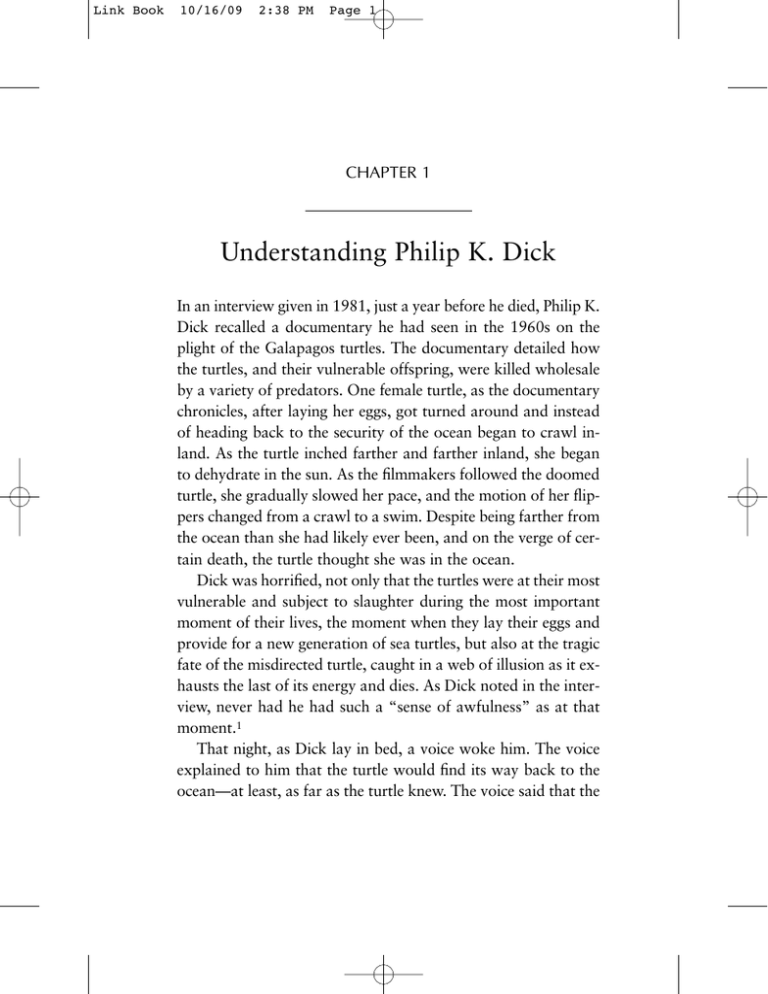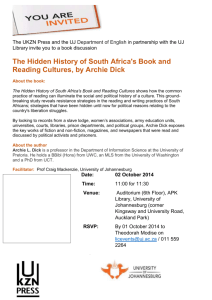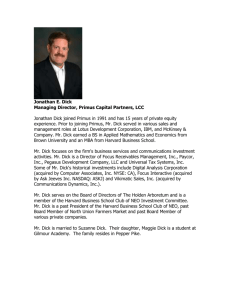Understanding Philip K. Dick CHAPTER 1
advertisement

Link Book 10/16/09 2:38 PM Page 1 CHAPTER 1 Understanding Philip K. Dick In an interview given in 1981, just a year before he died, Philip K. Dick recalled a documentary he had seen in the 1960s on the plight of the Galapagos turtles. The documentary detailed how the turtles, and their vulnerable offspring, were killed wholesale by a variety of predators. One female turtle, as the documentary chronicles, after laying her eggs, got turned around and instead of heading back to the security of the ocean began to crawl inland. As the turtle inched farther and farther inland, she began to dehydrate in the sun. As the filmmakers followed the doomed turtle, she gradually slowed her pace, and the motion of her flippers changed from a crawl to a swim. Despite being farther from the ocean than she had likely ever been, and on the verge of certain death, the turtle thought she was in the ocean. Dick was horrified, not only that the turtles were at their most vulnerable and subject to slaughter during the most important moment of their lives, the moment when they lay their eggs and provide for a new generation of sea turtles, but also at the tragic fate of the misdirected turtle, caught in a web of illusion as it exhausts the last of its energy and dies. As Dick noted in the interview, never had he had such a “sense of awfulness” as at that moment.1 That night, as Dick lay in bed, a voice woke him. The voice explained to him that the turtle would find its way back to the ocean—at least, as far as the turtle knew. The voice said that the Link Book 10/16/09 2:38 PM Page 2 2 / Understanding Philip K. Dick turtle had been supplied an alternate reality—a subjective reality—in which she truly believed she was in the ocean swimming freely. In the comforting light of this benevolent vision, the cruel fate of an inland death vanished for the turtle. The story Dick relates of the turtle is telling, and it reflects themes that would interest him throughout his thirty-year career as an author: the nature of subjective experience, the individual caught between shifting realities, the tragic and awful struggles of life, the irony of heading blithely in the wrong direction, the horror and pity of death. Even the voice Dick heard in the night—the moment of contact between the human and the transcendent—is an issue he returned to again and again in his novels and short stories. Whether in an interview or in an essay, when Philip K. Dick reveals he heard a voice talking to him in the still of the night, he is not necessarily speaking metaphorically. He may not understand how or why the voice has manifested itself to him, but he is generally sure he heard a voice. This anecdote is not the key to understanding Philip K. Dick; he is far too complex and multifaceted to be illuminated so simply. But the story of the turtle serves as a point of entry into the life and career of a man who some have claimed to be the greatest science fiction writer of the twentieth century. Whether the greatest or not, Dick is undeniably one of the most provocative, experimental, and challenging; he is a prolific writer who broke the rules of a genre and whose influence and importance— always admitted—seem to grow greater each year as a new generation of readers and critics comes to terms with the significance of his achievements within the field of science fiction and within twentieth-century American literary history. Philip K. Dick’s life was as provocative, as disturbing, and as filled with the uneasy juxtaposition of mundane events, all-toohuman failings, and profound mysteries as his novels.2 He was Link Book 10/16/09 2:38 PM Page 3 Understanding Philip K. Dick / 3 born in Chicago on December 16, 1928, to Joseph Edgar Dick and Dorothy Kindred Dick. Philip was the elder of a pair of twins. His twin sister, Jane, died a mere six weeks later. There is reason to suspect that Jane was undernourished and was not given proper and timely care by Edgar and Dorothy. The death of his twin—although he was too young to comprehend it at the time—would, in later years, haunt Philip, and even into his forties and fifties one finds him reflecting with great sorrow and bitterness on the loss. A few months after Jane’s death, the Dick family relocated briefly to Johnstown, Colorado, and then a month or two later to the San Francisco Bay area. In 1933 Philip’s parents divorced. Philip remained with his mother while Edgar moved to Reno, and from 1935 until their return to Berkeley in 1938, Philip and Dorothy lived in Washington, D.C. Dick began writing short stories while still attending public school in the Bay Area. A music fan, during his teens he held part-time jobs in two record stores, each catering to different musical tastes, and his knowledge of music, especially classical music, already great, continued to grow. The numerous allusions to music (both classical and popular) in his novels and short stories reflect this keen interest. During his high school years, Dick struggled with agoraphobia and other—primarily psychological—ailments, and received some psychotherapy in order to help him through this challenging time. In 1947 Dick enrolled in the University of California at Berkeley, but dropped out after only a few weeks. The reasons for the swift exit from school are uncertain, but likely had something to do with his unwillingness to participate in the Reserve Officers’ Training Corps (ROTC) program. The following year Dick married Jeanette Marlin. The marriage, which lasted only a few months, would prove to be the shortest of Dick’s five marriages (and, perhaps because of its brevity, it is the union his biographers know least about) His Link Book 10/16/09 2:38 PM Page 4 4 / Understanding Philip K. Dick second marriage, to Kleo Apostolides, in 1950 would prove more successful. The couple bought a small house in Berkeley, and Dick worked for a time in a record store. He also began to attend a series of writing workshops conducted by the science fiction writer and publisher Anthony Boucher, who encouraged Dick in his writing and bought his short story “Roog” in 1951. This marked his first sale, and inaugurated a thirty-year career as a writer. In 1952 Dick became a client of the Scott Meredith Literary Agency—a relationship that would last throughout his life—and, leaving his job at the record store, he set out to write full time. His first story to appear in print, “Beyond Lies the Wub,” appeared in the pulp magazine Planet Stories in 1952. During the early years of his writing career, Dick focused on short science fiction stories, which sold quickly to pulp magazines but earned him very little income. He also wrote the occasional mainstream novel, none of which were accepted for publication at the time, and only one of which, Confessions of a Crap Artist (written [w.] 1959, published [p.] 1975), was published in his lifetime By the middle of the 1950s, however, Dick, although still consumed with writing a growing stack of unpublished mainstream novels, turned the remainder of his energies away from short stories and toward science fiction novels. These science fiction novels found the success his mainstream novels did not. His first published science fiction novel, Solar Lottery, appeared in 1955. Dick’s life, already psychologically complicated by his penchant for phobias, his therapy sessions, the loss of his sister, his parents’ divorce, a strained relationship with a headstrong mother, and a short, failed first marriage, became even more complex. In the early 1950s he began to take amphetamines to treat his phobias—and soon thereafter as a means to fuel a physically Link Book 10/16/09 2:38 PM Page 5 Understanding Philip K. Dick / 5 taxing writing schedule. In addition, his phobias were reinforced by an encounter with Federal Bureau of Investigation (FBI) agents, who sought to recruit Dick and Kleo to relocate and report on student activities—presumably anti-American activities—at the University of Mexico. Dick and Kleo turned down the offer, but the recruitment visit by the FBI left a mark on Dick and fed his anxieties about government surveillance. These anxieties, fueled by a number of other incidents in later years, remained with him the rest of his life, and are reflected in many of his novels.3 Dick’s marriage to Kleo lasted until 1958, when he met Anne Rubenstein, a widow with three young girls. Kleo and Dick divorced, and Anne and Dick were married in 1959. The following year they had a daughter, Laura Archer Dick. During the 1950s Dick’s science fiction stories, then novels, including such solid efforts as Eye in the Sky (1957) and Time Out of Joint (1959), were published, but his mainstream novels found no outlets, and by the end of the decade Dick, tired and frustrated, was ready to walk away from the business, which he did briefly from late 1960 to early 1961. He spent those months helping his wife, Anne, with her custom jewelry business, but he soon found that the life of a jewelry designer was not for him, and he returned to writing, drafting and publishing his Hugo Award–winning The Man in the High Castle in 1962. The success of High Castle gave Dick the motivation he needed to renew his efforts, and he set aside his hope for mainstream success in order to focus full time on writing science fiction. During the next two years he would pen a dozen novels, including such masterpieces of the genre as Martian Time-Slip (w. 1962, p. 1964), Dr. Bloodmoney, or How We Got Along after the Bomb (w. 1963, p. 1965), and The Three Stigmata of Palmer Eldritch (w. 1964, p. 1965). Despite Link Book 10/16/09 2:38 PM Page 6 6 / Understanding Philip K. Dick these triumphs, Dick’s economic and marital woes continued, and his marriage to Anne ended with separation in 1964 and divorce in 1965. The following year Dick married his fourth wife, Nancy Hackett, and with her had a second child, a daughter, Isolde, in 1967. The late 1960s also proved productive, and Dick produced, among a host of other works, his well-known Do Androids Dream of Electric Sheep? (w. 1966, p. 1968; the novel became the basis for the movie Blade Runner) and the masterful Ubik (w. 1966, p. 1969). But in 1970 his marriage to Nancy ended in divorce, and Dick’s life grew increasingly chaotic as he delved deeper into the drug counterculture of the late 1960s and early 1970s. A mysterious break-in in his home in 1971, still unsolved, added to Dick’s increasing fear, depression, and anxiety—culminating, ultimately, in a failed suicide attempt in Vancouver in 1972. Following his suicide attempt, Dick was admitted to X-Kalay, a drug treatment facility, and a modestly cleaner Dick moved to Fullerton, California, in April 1972. Having befriended a professor at the University of California at Fullerton, Dick would sell his papers to the Special Collections department of the university library (where his papers reside currently). In 1973 Dick married Leslie (“Tessa”) Busby, his fifth and final wife (although this marriage also ended in divorce in 1976). The couple would have a son, Christopher Kenneth Dick, in 1973. The marriage to Tessa rejuvenated Dick, and after a two-year hiatus he began to write again, working on his dark masterpiece about the underbelly of the California drug culture, A Scanner Darkly, which was eventually published in 1977. He also published Flow My Tears, the Policeman Said in 1974 (it had been written primarily in 1970), which won the John W. Campbell Award for best science fiction novel of the year. Link Book 10/16/09 2:38 PM Page 7 Understanding Philip K. Dick / 7 In February and March 1974 Dick had a series of powerful mystical visions, and he began to keep a journal in an effort to record, explore, and explain these experiences. He called this journal, which he worked on for most of the remainder of his life, the Exegesis It would eventually run to some two million words. The failure of his marriage to Tessa in 1976 resulted in a second failed suicide attempt. Despite his battles with anxiety and depression, and his numerous failed marriages (as well as a host of failed romances with other women), the late 1970s did see Dick’s economic straits finally turn around as royalties from reprint editions of his works, foreign sales, and movie options (especially the option on Androids for the movie Blade Runner) began to afford Dick some much needed freedom from constant financial anxiety. His writing production—if one does not count the Exegesis—slowed during the late 1970s, but with the turn of the decade he wrote and published three final novels, two of which—VALIS (1981) and The Transmigration of Timothy Archer (published posthumously in 1982)—are among his best. He died on March 2, 1982, of heart failure following a series of strokes, and his ashes are buried next to those of his twin sister, Jane, in Fort Morgan, Colorado. Now, in his honor, the Philip K. Dick Award, sponsored by the Philadelphia Science Fiction Society with the support of the Philip K. Dick Trust, is given each year to the best original paperback novel in the field of science fiction. This brief biographical sketch records only some of the significant dates and names associated with Dick’s life. Important as these facts are, and as influential as the events of his life were upon his writings—Dick drew liberally and unashamedly upon the events in his own life, whether joyous, tragic, or mysterious—they only tell one piece of a much larger story. Dick was a Link Book 10/16/09 2:38 PM Page 8 8 / Understanding Philip K. Dick voracious consumer of ideas and a lover of philosophy. There was a restless quality to Dick’s mind. He would entertain all ideas, and reject them all just as easily, seeming to find more satisfaction in the perpetual quest for explanations of the philosophical dilemmas of human life than in the explanations themselves. He would embrace a theory—about God, about politics, about science, about anything—turn it on a spit in his mind until it was thoroughly cooked, then declare it overdone and toss it aside. Dick was intellectually driven, and his intellectual curiosity is reflected not only in the provocative treatments of complex philosophical themes in his works but also in the vast array of references one finds in his works to obscure and arcane knowledge from both Eastern and Western history. Although Dick rarely demonstrates his scholarly pursuits with the highbrow sophistication of a modernist text such as T. S. Eliot’s “The Waste Land,” he does in many works—and especially in his later novels of the early 1980s—display the playfully encyclopedic curiosity of postmodern authors like Thomas Pynchon. Dick once noted that the wide-ranging influences of the contemporary science fiction writer should include journals that “deal in the most advanced research of clinical psychology, especially the work of the European existential analysis school”—as well as studies of C. G. Jung, Zen Buddhism, and Taoism—and “really authoritative” historical studies. In addition, the writer should read “Medieval works, especially dealing with crafts, such as glass blowing—and science, alchemy, religion, etc. Greek philosophy, Roman literature of every sort. Persian religious texts. Renaissance studies on the theory of art. German dramatic writings of the Romantic Period” (Shifting Realities 64–65). This wide-ranging intellectual curiosity had a direct impact on his writing. One thing that distinguishes Dick’s work from Link Book 10/16/09 2:38 PM Page 9 Understanding Philip K. Dick / 9 much of the other narrative writing appearing month after month in the pulp magazines of the mid-twentieth century is its engagement with philosophical and theological ideas. In the midst of the psionic powers, aliens, space ships, and other paraphernalia of the genre, one finds Dick exploring pre-Socratic philosophy, world religions, and the epistemological theories of Descartes and Hume. Dick was no ivory tower intellectual, however, and his novels and short stories are as much about life in the United States in the mid-twentieth century as they are about arcane philosophical and theological concepts. In his work Dick responded to the climate of his times. In the 1950s, when Dick first turned his talents to serious writing, one can find clear reflections of the post–World War II era of cold war politics, atomic scares, bomb shelters, and McCarthyism. In the 1960s Dick’s work is heavily influenced by the Berkeley counterculture scene. Many of Dick’s best works from the 1960s directly engage the issue of drugs and drug culture, sometimes as metaphor and symbol, other times as tangible and tragic. One also finds Dick working out implications of the civil rights movement, the rise of the Black Panther Party, the shadowy activities of the Central Intelligence Agency (CIA), and the host of other social issues that the youth counterculture and the Beats gravitated to in their protests and writings. In the early 1970s Dick was enraged by Watergate, disenchanted with the outcomes of 1960s drug experimentation by the stoner youth culture in California, and disturbed—along with the nation—with the implications of the Vietnam War and its aftermath. Right up to the end of his life, Dick responded in his writing and in numerous interviews given during his last few years to the climate in America during the Carter and early Reagan administrations. To read the work of Philip K. Dick is not only to read Link Book 10/16/09 2:38 PM Page 10 10 / Understanding Philip K. Dick of the future but also to read a version of the history of U.S. culture throughout the entire cold war era. And he frames this history—both future and contemporary—in the conventions of pulp-era science fiction as well as in the deepest mysteries of world philosophy.



